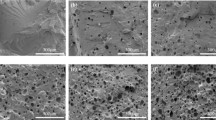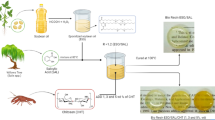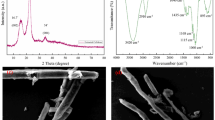Summary
Carboxymethylcellulose (CMC, DSCM = 1) was partially hydrophobized in order to prepare polymeric surfactants by the transesterification reaction using the methyl ester of the fatty acid complex of rapeseed oil (MERO). The chemical modification was performed in different reaction media (i) DMF/TSA and (ii) H2O/DMF with and without K2CO3 as catalyst, at various reaction conditions and using microwave radiation with controlled power as heating source. The obtained MERO-hydrophobized CMC (MH-CMC) comprising mixed fatty acyl esters were characterized by FT-IR and NMR spectroscopic techniques, which indicated a very low degree of esterification (DS < 0.1). The derivatives showed, in spite of moderate surface tension-lowering effects, excellent emulsifying activity for ‘oil in water’ type emulsions as well as good performance properties including washing power and antiredeposition efficiency. The results suggested that surface-active MH-CMC derivatives can be prepared under microwave heating at reaction times in the range of several minutes, what is a great advantage in comparison to transesterification reactions lasting up to 6 h at conventional heating. The novel CMC esters represent biodegradable polymeric surfactants with potential applications in manufacture of consumer products and in industrial processes.
Similar content being viewed by others
References
Feddersen RL, Thorp SN (1993) Sodium carboxymethylcellulose. In: Whistler RL and BeMiller JA (ed) Industrial Gums, Polysaccharides and their Derivatives, Academic Press, San Diego New York Boston, 537
Vogt S, Klemm D, Heinze T (1996) Polym Bull 36:549
Heinze T, Dicke R, Koschella A, Kull A, Klohr EA, Koch W (2000) Macromol Chem Phys 201:627
Charpentier D, Mocanu G, Carpov A, Chapelle S, Merle L, Muller G (1997) Carbohydr Polym 33:177
Sroková I, Talaba P, Hodul P, Balažová A (1998) Tenside Surf Det 35:342
Cao Y, Li HL (2002) Eur Polym J 38:1457
Aburto J, Alric I, Borredon E (1999) Starch/Stärke 51:132
Vaca-Garcia C, Thiebaud S, Borredon ME, Gozzelino G (1998) J Am Oil Chem Soc 75:315
Vaca-Garcia C, Borredon ME (1999) Bioresource Technol 70:135
Neumannn U, Wiege B, Warwel S (2002) Starch/Stärke 54:449
Latetin AI, Gal’braikh LS, Rogovin ZA (1968) Polym Sci USSR 10:761
Rooney ML (1976) Polymer 17:555
Aburto J, Alric I, Borredon E (2005) Starch/Stärke 57:145
Mormann W, Al-Higari M (2004) Starch/Stärke 56:118
Žoldáková A, Sroková I, Sasinková V, Hirsch J, Ebringerová A (2005) Chem Pap 59:362
Skalková P, Sroková I, Sasinková V, Ebringerová A (2006) Tenside Surf Det 43:137
Sroková I, Tomanová V, Ebringerová A, Maloviková A, Heinze T (2004) Macromol Mater Eng 289:63
Galema SA (1997) Chemical Society Reviews 26:233
Koroskenyi B, McCarthy SP (2002) J Polym Environ 10:93
Bogdal D, Penczek P, Pielichowski J, Prociak A (2003) Adv Polym Sci 163:194
Gourson C, Benhaddou R, Granet R, Krausz P, Saulnier L, Thibault JF (1999) Compt Rend Ac Sci, Ser. IIc, Chim 2:75
Lewandowicz G, Fornal J, Walkowski A, Maczynski M, Urbaniak G, Szymanska G (2000) Industrial Crops and Products 11:249
Satgé C, Verneuil B, Branland P, Granet R, Krausz P, Rozier J, Petit C (2002) Carbohydr Polym 49:373
Antova G, Vasvasova P, Zlatanov M (2004) Carbohydr Polym 57:131
Sroková I, Čížová A, Sasinková V, Hromádková Z, Ebringerová A (2006) Micowave-assisted transesterification of O-(carboxymethyl)starch. In: Pielichowski K (ed) Modern Polymeric Materials for Environmental Applications, Wydavnictwo DjaF, Krakow, vol. 2, pp 31-36
Fang JM, Fowler PA, Tomkinson J, Hill CAS (2002) Carbohydr Polym 50:429
Hromádková Z, Kováčiková J, Ebringerová A (1999) Ind Crops Prod 9:101
Sroková I, Ebringerová A, Heinze T (2001) Tenside Surf Det 38:277
Stüpel H (1997) Synthetische Wasch-und Reinigungsmittel. 1st edition, Konradin Verlag, Stuttgart
Reuben J, Conner HT (1983) Carbohydr Res 115:1
Grote C, Heinze T (2005) Cellulose 12:435
Kamide K, Okajima K, Kowasaka K, Matsui M (1987) Polym J 19:1405
Singh V, Sethi R, Tewari A, Srivastava V, Sangh R (2003) Carbohydr Polym 54:523
Dickinson E (1988). The role of hydrocolloids in stability of particulate dispersions and emulsions. In: Philipps GO, Wedlock O J, Williams PH (ed) Gums and Stabilisers for the Food industry. IRL Press, Oxford, vol 4, pp. 249-263
Garti N, Leser ME (2001) Polym Adv Technol 12:123
Paik YH, Swift G (1995) Chem Ind 2:55
Author information
Authors and Affiliations
Corresponding author
Rights and permissions
About this article
Cite this article
Tomanová, V., Pielichowski, K., Sroková, I. et al. Microwave-assisted synthesis of carboxymethylcellulose – based polymeric surfactants. Polym. Bull. 60, 15–25 (2008). https://doi.org/10.1007/s00289-007-0834-1
Received:
Revised:
Accepted:
Published:
Issue Date:
DOI: https://doi.org/10.1007/s00289-007-0834-1




